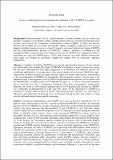Diverse evolutionary roots and mechanistic variations of the CRISPR-Cas systems
Author(s)
Mohanraju, Prarthana; Makarova, Kira S.; Koonin, Eugene V.; van der Oost, John; Zetsche, Bernd; Zhang, Feng; ... Show more Show less
DownloadZhang5.pdf (18.79Mb)
OPEN_ACCESS_POLICY
Open Access Policy
Creative Commons Attribution-Noncommercial-Share Alike
Terms of use
Metadata
Show full item recordAbstract
Adaptive immunity had been long thought of as an exclusive feature of animals. However, the discovery of the CRISPR-Cas defense system, present in almost half of prokaryotic genomes, proves otherwise. Because of the everlasting parasite-host arms race, CRISPR-Cas has rapidly evolved through horizontal transfer of complete loci or individual modules, resulting in extreme structural and functional diversity. CRISPR-Cas systems are divided into two distinct classes that each consist of three types and multiple subtypes. We discuss recent advances in CRISPR-Cas research that reveal elaborate molecular mechanisms and provide for a plausible scenario of CRISPR-Cas evolution. We also briefly describe the latest developments of a wide range of CRISPR-based applications.
Date issued
2016-08Department
Broad Institute of MIT and Harvard; Massachusetts Institute of Technology. Department of Brain and Cognitive SciencesJournal
Science
Publisher
American Association for the Advancement of Science (AAAS)
Citation
Mohanraju, Prarthana et al. “Diverse Evolutionary Roots and Mechanistic Variations of the CRISPR-Cas Systems.” Science 353, 6299 (August 2016): aad5147 © 2016 American Association for the Advancement of Science
Version: Author's final manuscript
ISSN
0036-8075
1095-9203